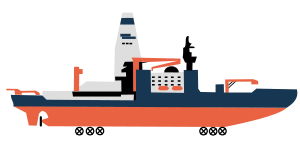 rough sketch of ERI Aurora Borealis
| |
| History | |
|---|---|
| Name | Aurora Borealis |
| Namesake | Aurora Borealis |
| Operator | European Science Foundation |
| Cost |
|
| General characteristics (initial concept)[1] | |
| Type | Icebreaker |
| Displacement | 65,000 tons |
| Length | 199.85 m (655.7 ft) |
| Beam |
|
| Draught | 13 m (43 ft) |
| Ice class | Polar Class 1 |
| Installed power | Eight main generators, 94 MW |
| Propulsion |
|
| Speed |
|
| Endurance | 90 days |
| Crew | Accommodations for 120 personnel (science and crew) |
| Aviation facilities | 2 helipads, hangar for 3 helicopters |
Aurora Borealis is a proposed European research icebreaker, comparable to the world's strongest icebreakers,[2] planned jointly by a consortium of fifteen participant organizations and companies[3] from ten European nations. If built, she would be the largest icebreaker ever built as well as the first icebreaker built to the highest IACS ice class, Polar Class 1.
The unique feature of the proposed vessel is its ability to perform scientific deep sea drilling in a sea ice covered ocean. The ship is proposed to have an operational lifetime of 35 to 40 years, with the main area of operations being the inner Arctic Ocean.
- ^ Technical details Archived April 25, 2012, at the Wayback Machine. European Research Icebreaker AURORA BOREALIS. Retrieved 2011-12-23.
- ^ Data Sheet for Overview Archived October 30, 2012, at the Wayback Machine. Retrieved 2012-10-09.
- ^ "Aurora Borealis: European Research Icebreaker". European Science Foundation. Archived from the original on April 16, 2009. Retrieved 2009-05-25.